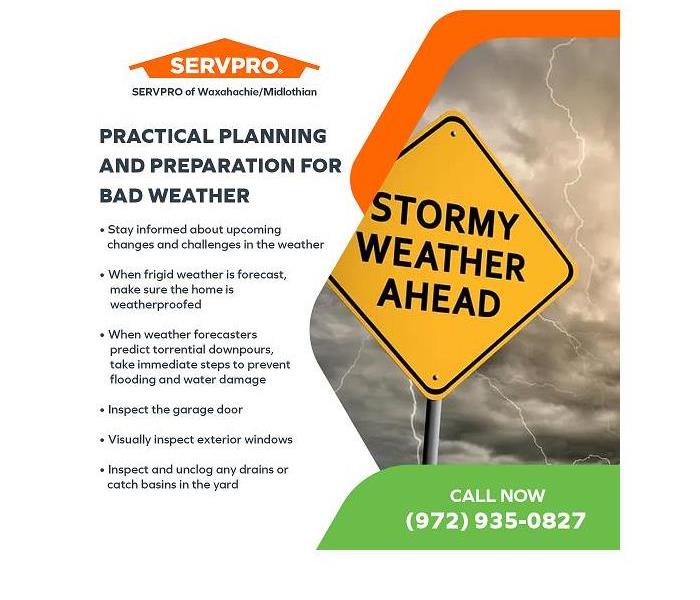Prevention Tips to Protect Midlothian, TX, Homes from Water and Flood Damage Caused by Winter Storms
2/8/2023 (Permalink)
Blog Summary: SERVPRO of Waxahachie/Midlothian highlights practical ways Midlothian, TX, residents can prepare for winter weather and avoid water and flood damage.
SERVPRO® of Waxahachie/Midlothian provides water damage and flood restoration services in all seasons and for any situation. Water damage and flood damage may be caused by severe thunderstorms and high winds. The culprit may be frozen pipes from frigid temperatures or flooding from torrential downpours, such as the rainfall that occurred in February 2018.
The Dallas-Fort Worth area is recognized for its tolerably mild winters and sometimes intolerably hot summers. However, frigid temperatures and frozen precipitation in the form of sleet, snow, and freezing rain can bring life to a standstill for days, as was the case in February of 2021. The wind and solar power grid completely collapsed, leaving hundreds of thousands in their cold, dark homes. Nearly 300 people lost their lives.
Many lessons were learned from this weather crisis experience. One of the most important lessons to emerge from this tragic catastrophe is the need for preparation at a level that could sustain a family through an extended period of time with limited or no infrastructure services such as power and water. The failure of the power grid meant no lights, no heat, and no cooking for many families. Many people were without water because their pipes froze and burst. Three of Fort Worth’s water treatment plants went offline due to the widespread power grid collapse. A cascade of catastrophes left the general population of North Texas cold, hungry, in the dark, and in danger for their lives.
Winter weather warnings and advisories
To survive a widespread weather catastrophe, residents need to know how to interpret and respond to the various types of winter weather advisories and warnings issued by the National Weather Service. Residents in the affected areas also need to make preparations for a winter weather worst-case scenario. The vulnerability of the power grid drives home the need to prepare not just for a fifty-year snowstorm but for the collapse of the power grid that could last days and weeks due to weather conditions that may not be all that severe. The key is to be prepared, stay vigilant, and respond correctly to the situation.
- An “advisory” indicates if caution is exercised, these events should not threaten lives.
- A “watch” indicates that hazardous conditions are possible, and residents must stay informed of any changes.
- A “warning” means situations are potentially life-threatening, and residents should take immediate action to ensure their preparedness and survival.
These alerts from the National Weather Service should be taken seriously and acted upon promptly and appropriately. The proper response at the right time will save lives.
Practical planning and preparation for bad weather
Tip: Stay informed about upcoming changes and challenges in the weather. Modern weather forecasting can provide residents with advisories, watches, and warnings so they can be ready when rough weather arrives. Keep two weather radios on hand and loaded with fresh batteries, and keep a supply of batteries dedicated to powering the weather radios.
Tip: When frigid weather is forecast, make sure the home is weatherproofed to prevent water damage. Cover external faucets with insulation, and wrap exposed pipes with insulation. When temperatures plummet, turn on faucets to allow for a steady drip or slow trickle. Open the cabinet doors below the sink to allow the home’s heat to warm the pipes under the sink.
Tip: When weather forecasters predict torrential downpours, as was experienced in 2018, take immediate steps to prevent flooding and water damage. Inspect and clean out gutters. Make sure that downspouts are connected, and extensions direct the water away from the foundation. The grade around the foundation should be 1 inch of slope per foot for at least six to ten feet away from the home. Inspect the sump pump system. Clean out any debris in the sump area. Pour a bucket of water into the sump area to ensure the pump works. Test the backup sump pump as well. Inspect the attic and mark any areas where a leak is suspected. If time permits, have the roof inspected by a licensed roofing contractor. After the wet or snowy weather, reinspect the attic for any evidence of new leaks.
Tip: Inspect the garage door, the first line of defense against flooding in the garage. If needed, replace the weather stripping on the bottom of the door to prevent water from leaking into the garage.
Tip: Visually inspect exterior windows. The windows should be closed. Look for cracked or broken panes that could allow for a water intrusion.
Tip: Inspect and unclog any drains or catch basins in the yard. The fall leaf shed can greatly reduce the flow rate of water into the drain or basin, resulting in a micro flood of catastrophic proportions for that home.
The tips listed above will help prevent water damage and flood damage when temperatures are frigid, and the rain gauge is overflowing from an extended torrential downpour. When a property damage disaster strikes, trust the cleanup and restoration project to the team at SERVPRO of Waxahachie/Midlothian. Since the locally owned company is centrally located in Ellis County, a team of IICRC-certified technicians can arrive on-scene in about thirty minutes, 24/7, 365 days a year, including holidays. The rapid response and quick cleanup and restoration process get life back to normal as soon as possible.
To learn more about flood restoration services, call SERVPRO of Waxahachie/Midlothian at (972) 935-0827 or email at acarey@SERVPRO10932.com.



 24/7 Emergency Service
24/7 Emergency Service
